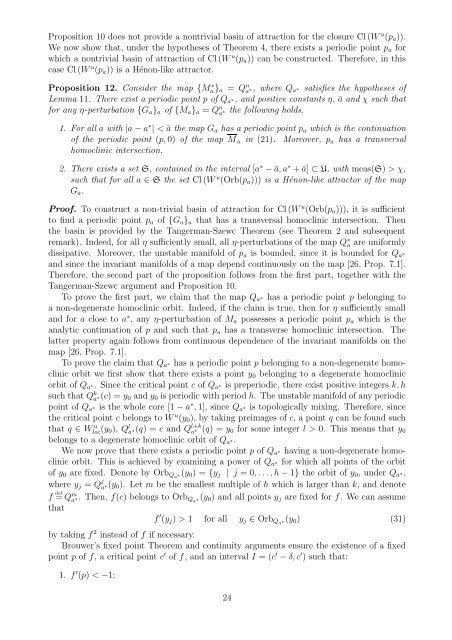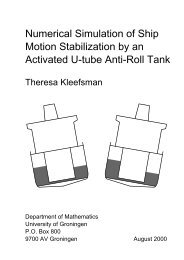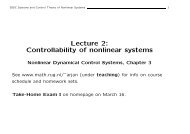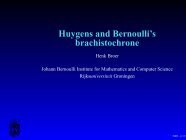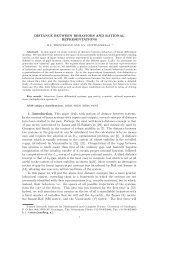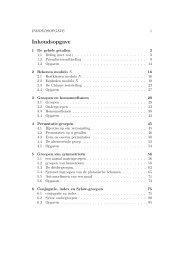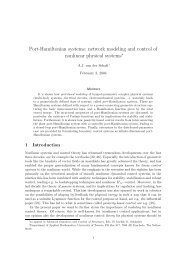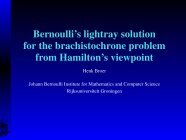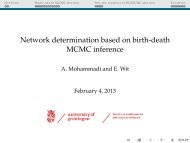Chaos and quasi-periodicity in diffeomorphisms of the solid torus
Chaos and quasi-periodicity in diffeomorphisms of the solid torus
Chaos and quasi-periodicity in diffeomorphisms of the solid torus
You also want an ePaper? Increase the reach of your titles
YUMPU automatically turns print PDFs into web optimized ePapers that Google loves.
Proposition 10 does not provide a nontrivial bas<strong>in</strong> <strong>of</strong> attraction for <strong>the</strong> closure Cl (W u (p a )).<br />
We now show that, under <strong>the</strong> hypo<strong>the</strong>ses <strong>of</strong> Theorem 4, <strong>the</strong>re exists a periodic po<strong>in</strong>t p a for<br />
which a nontrivial bas<strong>in</strong> <strong>of</strong> attraction <strong>of</strong> Cl (W u (p a )) can be constructed. Therefore, <strong>in</strong> this<br />
case Cl (W u (p a )) is a Hénon-like attractor.<br />
Proposition 12. Consider <strong>the</strong> map {Ma ∗ } a = Q n a ∗, where Q a∗ satisfies <strong>the</strong> hypo<strong>the</strong>ses <strong>of</strong><br />
Lemma 11. There exist a periodic po<strong>in</strong>t p <strong>of</strong> Q a ∗, <strong>and</strong> positive constants η, ā <strong>and</strong> χ such that<br />
for any η-perturbation {G a } a <strong>of</strong> {M a } a = Q n a <strong>the</strong> follow<strong>in</strong>g holds.<br />
∗<br />
1. For all a with |a − a ∗ | < ā <strong>the</strong> map G a has a periodic po<strong>in</strong>t p a which is <strong>the</strong> cont<strong>in</strong>uation<br />
<strong>of</strong> <strong>the</strong> periodic po<strong>in</strong>t (p, 0) <strong>of</strong> <strong>the</strong> map M a <strong>in</strong> (21). Moreover, p a has a transversal<br />
homocl<strong>in</strong>ic <strong>in</strong>tersection.<br />
2. There exists a set S, conta<strong>in</strong>ed <strong>in</strong> <strong>the</strong> <strong>in</strong>terval [a ∗ − ā, a ∗ + ā] ⊂ U, with meas(S) > χ,<br />
such that for all a ∈ S <strong>the</strong> set Cl (W u (Orb(p a ))) is a Hénon-like attractor <strong>of</strong> <strong>the</strong> map<br />
G a .<br />
Pro<strong>of</strong>. To construct a non-trivial bas<strong>in</strong> <strong>of</strong> attraction for Cl (W u (Orb(p a ))), it is sufficient<br />
to f<strong>in</strong>d a periodic po<strong>in</strong>t p a <strong>of</strong> {G a } a that has a transversal homocl<strong>in</strong>ic <strong>in</strong>tersection. Then<br />
<strong>the</strong> bas<strong>in</strong> is provided by <strong>the</strong> Tangerman-Szewc Theorem (see Theorem 2 <strong>and</strong> subsequent<br />
remark). Indeed, for all η sufficiently small, all η-perturbations <strong>of</strong> <strong>the</strong> map Q ∗ a are uniformly<br />
dissipative. Moreover, <strong>the</strong> unstable manifold <strong>of</strong> p a is bounded, s<strong>in</strong>ce it is bounded for Q a ∗<br />
<strong>and</strong> s<strong>in</strong>ce <strong>the</strong> <strong>in</strong>variant manifolds <strong>of</strong> a map depend cont<strong>in</strong>uously on <strong>the</strong> map [26, Prop. 7.1].<br />
Therefore, <strong>the</strong> second part <strong>of</strong> <strong>the</strong> proposition follows from <strong>the</strong> first part, toge<strong>the</strong>r with <strong>the</strong><br />
Tangerman-Szewc argument <strong>and</strong> Proposition 10.<br />
To prove <strong>the</strong> first part, we claim that <strong>the</strong> map Q a ∗ has a periodic po<strong>in</strong>t p belong<strong>in</strong>g to<br />
a non-degenerate homocl<strong>in</strong>ic orbit. Indeed, if <strong>the</strong> claim is true, <strong>the</strong>n for η sufficiently small<br />
<strong>and</strong> for a close to a ∗ , any η-perturbation <strong>of</strong> M a possesses a periodic po<strong>in</strong>t p a which is <strong>the</strong><br />
analytic cont<strong>in</strong>uation <strong>of</strong> p <strong>and</strong> such that p a has a transverse homocl<strong>in</strong>ic <strong>in</strong>tersection. The<br />
latter property aga<strong>in</strong> follows from cont<strong>in</strong>uous dependence <strong>of</strong> <strong>the</strong> <strong>in</strong>variant manifolds on <strong>the</strong><br />
map [26, Prop. 7.1].<br />
To prove <strong>the</strong> claim that Q a ∗ has a periodic po<strong>in</strong>t p belong<strong>in</strong>g to a non-degenerate homocl<strong>in</strong>ic<br />
orbit we first show that <strong>the</strong>re exists a po<strong>in</strong>t y 0 belong<strong>in</strong>g to a degenerate homocl<strong>in</strong>ic<br />
orbit <strong>of</strong> Q a ∗. S<strong>in</strong>ce <strong>the</strong> critical po<strong>in</strong>t c <strong>of</strong> Q a ∗ is preperiodic, <strong>the</strong>re exist positive <strong>in</strong>tegers k, h<br />
such that Q k a ∗(c) = y 0 <strong>and</strong> y 0 is periodic with period h. The unstable manifold <strong>of</strong> any periodic<br />
po<strong>in</strong>t <strong>of</strong> Q a ∗ is <strong>the</strong> whole core [1 − a ∗ , 1], s<strong>in</strong>ce Q a ∗ is topologically mix<strong>in</strong>g. Therefore, s<strong>in</strong>ce<br />
<strong>the</strong> critical po<strong>in</strong>t c belongs to W u (y 0 ), by tak<strong>in</strong>g preimages <strong>of</strong> c, a po<strong>in</strong>t q can be found such<br />
that q ∈ Wloc u (y 0), Q l a∗(q) = c <strong>and</strong> Ql+k a (q) = y ∗ 0 for some <strong>in</strong>teger l > 0. This means that y 0<br />
belongs to a degenerate homocl<strong>in</strong>ic orbit <strong>of</strong> Q a ∗.<br />
We now prove that <strong>the</strong>re exists a periodic po<strong>in</strong>t p <strong>of</strong> Q a ∗ hav<strong>in</strong>g a non-degenerate homocl<strong>in</strong>ic<br />
orbit. This is achieved by exam<strong>in</strong><strong>in</strong>g a power <strong>of</strong> Q a ∗ for which all po<strong>in</strong>ts <strong>of</strong> <strong>the</strong> orbit<br />
<strong>of</strong> y 0 are fixed. Denote by Orb Qa ∗(y 0 ) = {y j | j = 0, . . . , h − 1} <strong>the</strong> orbit <strong>of</strong> y 0 , under Q a ∗,<br />
where y j = Q j a ∗(y 0). Let m be <strong>the</strong> smallest multiple <strong>of</strong> h which is larger than k, <strong>and</strong> denote<br />
f def<br />
= Q m a ∗. Then, f(c) belongs to Orb Q a ∗(y 0 ) <strong>and</strong> all po<strong>in</strong>ts y j are fixed for f. We can assume<br />
that<br />
f ′ (y j ) > 1 for all y j ∈ Orb Qa ∗(y 0 ) (31)<br />
by tak<strong>in</strong>g f 2 <strong>in</strong>stead <strong>of</strong> f if necessary.<br />
Brouwer’s fixed po<strong>in</strong>t Theorem <strong>and</strong> cont<strong>in</strong>uity arguments ensure <strong>the</strong> existence <strong>of</strong> a fixed<br />
po<strong>in</strong>t p <strong>of</strong> f, a critical po<strong>in</strong>t c ′ <strong>of</strong> f, <strong>and</strong> an <strong>in</strong>terval I = (c ′ − δ, c ′ ) such that:<br />
1. f ′ (p) < −1;<br />
24


